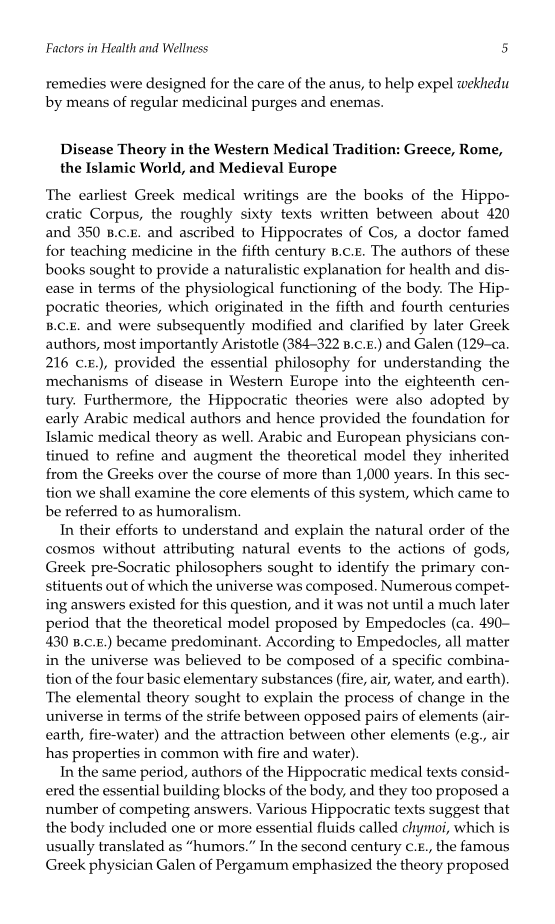Factors in Health and Wellness 5 remedies were designed for the care of the anus, to help expel wekhedu by means of regular medicinal purges and enemas. Disease Theory in the Western Medical Tradition: Greece, Rome, the Islamic World, and Medieval Europe The earliest Greek medical writings are the books of the Hippo - cratic Corpus, the roughly sixty texts written between about 420 and 350 b.c.e. and ascribed to Hippocrates of Cos, a doctor famed for teaching medicine in the fifth century b.c.e. The authors of these books sought to provide a naturalistic explanation for health and dis- ease in terms of the physiological functioning of the body. The Hip- pocratic theories, which originated in the fifth and fourth centuries b.c.e. and were subsequently modified and clarified by later Greek authors, most importantly Aristotle (384–322 b.c.e.) and Galen (129–ca. 216 c.e.), provided the essential philosophy for understanding the mechanisms of disease in Western Europe into the eighteenth cen- tury. Furthermore, the Hippocratic theories were also adopted by early Arabic medical authors and hence provided the foundation for Islamic medical theory as well. Arabic and European physicians con- tinued to refine and augment the theoretical model they inherited from the Greeks over the course of more than 1,000 years. In this sec- tion we shall examine the core elements of this system, which came to be referred to as humoralism. In their efforts to understand and explain the natural order of the cosmos without attributing natural events to the actions of gods, Greek pre-Socratic philosophers sought to identify the primary con- stituents out of which the universe was composed. Numerous compet- ing answers existed for this question, and it was not until a much later period that the theoretical model proposed by Empedocles (ca. 490– 430 b.c.e.) became predominant. According to Empedocles, all matter in the universe was believed to be composed of a specific combina- tion of the four basic elementary substances (fire, air, water, and earth). The elemental theory sought to explain the process of change in the universe in terms of the strife between opposed pairs of elements (air- earth, fire-water) and the attraction between other elements (e.g., air has properties in common with fire and water). In the same period, authors of the Hippocratic medical texts consid- ered the essential building blocks of the body, and they too proposed a number of competing answers. Various Hippocratic texts suggest that the body included one or more essential fluids called chymoi , which is usually translated as “humors.” In the second century c.e., the famous Greek physician Galen of Pergamum emphasized the theory proposed
Document Details My Account Print multiple pages
Print
You have printed 0 times in the last 24 hours.
Your print count will reset on at .
You may print 0 more time(s) before then.
You may print a maximum of 0 pages at a time.

















































































































































































































































































